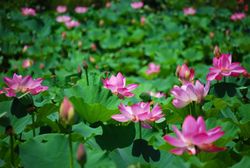Lotus
| Lotus |
|---|
| Scientific Classification |
|
| Scientific Name |
| Nelumbo nucifera |
| purple lotus blooms in lake Okeechobee |
The Sacred lotus is a species of lotus known by the scientific name Nelumbo nucifera. It has many ties and meanings behind it, it is very important to many religions such as Buddhism. This flower is found in southern Asia and Australia, it is the national flower for India and has been artificially introduced to the U.S. in places such as Louisiana, Kentucky, and Florida. This flower has to be in weather that is at least thirty-two to thirty-four degrees Fahrenheit and can generate heat for itself in order to ensure it says that temperature. This flower comes in may colors and believe it or not styles, they can be purple, pink, yellow, blue, even white, and they can be big pedaled, or have long skinny pedals. this plants seeds may need a certain degree of heat to survive but they can live up to two hundred years an can still bloom.
Body Design
The Lotus is a aquatic perennial, meaning it only grows in shallow murky waters such as ponds or lakes and It is native to southern Asia and Australia. This flower is what we call a dicot, which means it already has two leaves formed in the seed so when it sprouts out of the deep mud in the water, the seed splits in two and the leaves grow with the plant once the flowers stem has reached the surface to looks like a sort of like a circle with medium sized honeycomb type structures in it that carry seeds and when the flower begins to bloom the seeds are pushed out and fall to the waters bodies floor to grow more flowers.
The long flexible stem, that can reach up to forty-nine inches in height but is ten feel horizontally and the flower itself can be eight inches in diameter and grows up to 12 inches above the water, contains air pockets to maintain buoyancy, the stem grows through the water and reaches the surface, sometimes the leaves are seen and other times are hidden below the surface but the flower is always visible.The lotus needs constant sunlight and is completely intolerant of the cold which is why it never sprouts in the winter, however during the night when the temperature drops it with close its blossom and just barley submerge itself and then resurface when the sun comes up in the morning.[2]. This flower is not only known for its beauty it is also very famous for its odor which its described as "citrusy" and "spicy" while being very pungent and intoxicating but once the flower has been cut from its stem the sent quickly fades over time.[3]
Life Cycle
the life cycle of this flower begins with its reproduction This plants reproduction is reliant on seed dispersal but can also be reproduced by using its' rhizomes, which are horizontal underground plant stem capable of producing the shoot and root systems of a new plant. After the seeds are formed in the head of the seed they mature and grow threw the water with the flower and after the flower dies they are dropped into the water to reproduce more plants. The oldest seed able to be germinated was found in China, in a lake bed, and was recorded to be over 1,200 years old. Since this plant can only flourish and thrive in very warm climates when it begins to get cold it can't generate its own heat and regulate its temperature so this flower always stays around thirty-two to thirty-four degrees over a two to three day period, while the environmental temperature varies by up to thirty degrees, oddly behaving like a warm blooded animal. This flower is also edible and is used in many food dishes, the pedals are used as a garnish, the leaves are mostly served as the wrap in many rolls, and the rhizomes are used in stir fry. [4]
Ecology
This flower will not survive in low temperatures it requires a heat of about thirty-two to thirty-four degrees at all times and can generate its own hate to ensure that. It grows out of murky, muddy lakes and ponds. Natively found in southern Asia and Australia it is mostly a tropical flower. It is a flower that multiplies fast when given the right conditions but many things eat this flower besides humans it is a tasty treat for many any animals such as Indian runner ducks, Whitetail Deer, Night Heron, Red Bellied Turtle, and the Flagfish. as for this flowers amazing odor it attracts many people to the lake Okeechobee in Florida with its thousands of lotus plants spread throughout.[5]
Religious Aspects
This flower has many ties with many religions and countries, it has earned its nickname the "sacred lotus". The Lotus plays a role in many Indian religions such as Hinduism, Buddhism, Sikhism, and Jainism, where it is a representation of untouched beauty and non-attachment. They believe that the flower, growing through the muddy, murky, waters and arising untouched and beautiful at the top, shows how people should go through life. Since this flower has many ties with many regions with strong roots in India it is India's' national flower. While this flower means many different things to many different people the most popular seems to be rebirth and starting a new.[6]
Video
The blooming of the lotus
References
- ↑ plants profile "US department of agriculture" . web. accessed on may 18, 2017. author unknown
- ↑ Lotus Flower "The Flower Expert" . web. Last modified on May 7, 2017. author unknown
- ↑ Kevin flower de lotus "Now Smell This" . web. wrote on 20 May 2009.
- ↑ Osborne, Airin The Sacred Lotus (Nelumbo nucifera) "The Sacred Lotus (Nelumbo nucifera) . web. wrote on: February 19, 2008
- ↑ Biogeography/Ecology/Habitat "LOTUS PLANT" . web. author unknown. accessed may 18, 2017.
- ↑ lotus "Religion Facts" . web. author unknown. Last Updated January 27, 2017.



